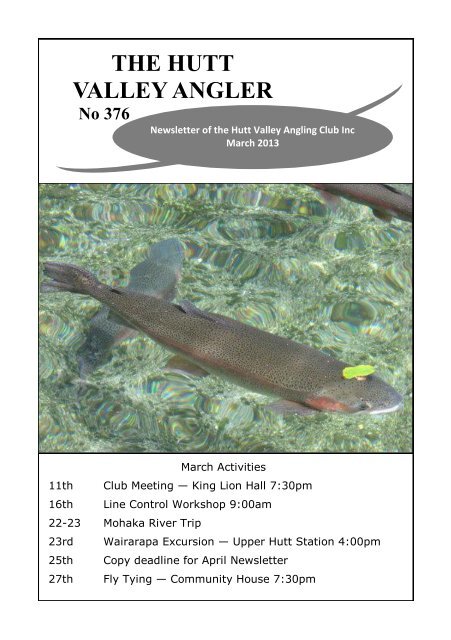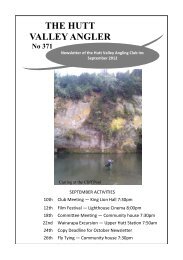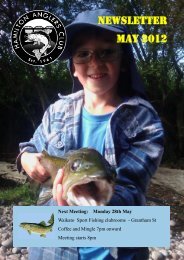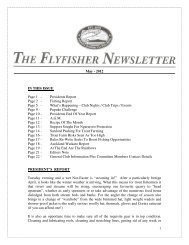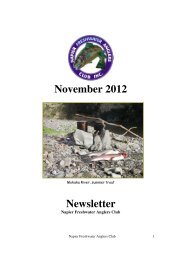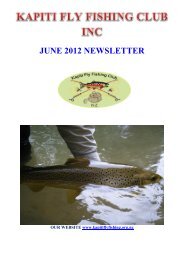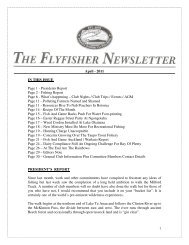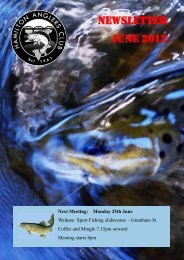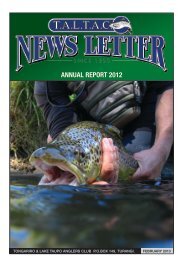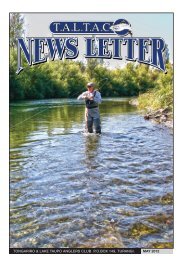HVAV Newsletter March 2013 - Christchurch Fishing and Casting Club
HVAV Newsletter March 2013 - Christchurch Fishing and Casting Club
HVAV Newsletter March 2013 - Christchurch Fishing and Casting Club
You also want an ePaper? Increase the reach of your titles
YUMPU automatically turns print PDFs into web optimized ePapers that Google loves.
THE HUTTVALLEY ANGLERNo 376<strong>Newsletter</strong> of the Hutt Valley Angling <strong>Club</strong> Inc<strong>March</strong> <strong>2013</strong><strong>March</strong> Activities11th <strong>Club</strong> Meeting — King Lion Hall 7:30pm16th Line Control Workshop 9:00am22-23 Mohaka River Trip23rd Wairarapa Excursion — Upper Hutt Station 4:00pm25th Copy deadline for April <strong>Newsletter</strong>27th Fly Tying — Community House 7:30pm
EditorialI should say ditto this month because the expected Cicada seasonis only just getting underway. Unfortunately due to this dry spellthe rivers are warming up <strong>and</strong> of course the Cyanobacteria isproliferating in the Hutt River. We need a flush every three or fourweeks to freshen the riverbed.It is most gratifying to see the interest <strong>and</strong> enthusiasm at ourIntroduction to Fly <strong>Fishing</strong> courses. Hopefully some of theparticipants will take the next step to join a fishing club where theycan expect to learn a great deal more about the sport.It’s great to welcome back Wood’s Waffles after a short sabbatical.Jeff always gives us articles to get the grey matter working a littlebit.John MillarEditorPresident’s PieceIsn’t it great to have such a stunning spell ofweather, although others are not so happywith it! No doubt many of you have beenout with those cicada patterns on local riversas a result.It was very pleasing to see several new facesat the February club meeting <strong>and</strong> othershave made contact about joining the club.This is in no small part to the accessibility ofour website. A number have commented on the information itprovides. The updates from a number of you on your fishing tripsover the summer made for an interesting session.By the time this goes to press, we would have held our twoGreater Wellington Regional Council sessions with over 40 peopleattending. The first session went extremely well with very positivefeedback received from those attending <strong>and</strong> from our colleagues in2Hutt Valley Angling <strong>Club</strong> Incorporated .<strong>March</strong> <strong>2013</strong>
the Greater Wellington Council. I would like to thank the membersof the committee <strong>and</strong> those others from the club who providedassistance on both days. Also our thanks to Fish & Game who hadinput <strong>and</strong> were able to provide information on their activities.It was good to welcome Pat van Berkel from the ‘Friends of theHutt River’ at the February meeting. Pat gave us some insight intotheir activities <strong>and</strong> what concerns they shared with us. The healthof the Hutt River in particular <strong>and</strong> all rivers generally should be ofconcern to us. A long term sustainable fishery is vital, as well as asign of a well-managed <strong>and</strong> healthy river environment. We willlook to have updates for on this over the year ahead.It was very pleasing to see the support for the Wainuiomata day<strong>and</strong> also the numbers going on the Mohaka trip. If any of you haveideas for club trips then can you please let one of the committeeknow, we are more than willing to look at new locations.We now have confirmed dates for the sessions being run by PaulBell <strong>and</strong> Paul Dewar respectively. The club is very lucky to havesomeone of Paul Bell’s experience in the club <strong>and</strong> I wouldencourage those that are available, to attend. The same with PaulDewar– having a member of the Silver Flies being willing to lead anon-river session for us is a great win for the club so we hope thatthese are well supported.We are also working on the Fly Tying Competition that we arehosting this year <strong>and</strong> planned for October. We are looking at someminor changes <strong>and</strong> will be progressing this over the next month orso with the Kapiti <strong>and</strong> Wellington <strong>Club</strong>s.Quote of the month:"The charm of fishing is that it is the pursuit of what is elusive butattainable, a perpetual series of occasions for hope." –John BuchanFraserGreen Trout GuidingSponsor of the <strong>Club</strong>’s Guiding RafflePhone Jim Rainey (06) 382-5507Kawhatau Valley Road, RD7, Mangawekaoffice@greentroutguiding.co.nz www.greentroutguiding.co.nzHutt Valley Angling <strong>Club</strong> Incorporated—<strong>March</strong> <strong>2013</strong>3
<strong>Club</strong> News<strong>Club</strong> Monthly Meeting 11 <strong>March</strong> — 7:30pm King Lion HallFilm Night — We will watch a new DVD on Fly <strong>Fishing</strong>.The high quality of the photography which includes underwaterfootage brings the viewer into the fish’s world.There are tips on fly tying included in this movie.Line Control Workshop- Saturday 16 <strong>March</strong> 9:00amThis session will be run on the Hutt River (Location to beadvised) by Paul Bell who will demonstrate how to control afloating fly line when nymphing or fishing upstream.Paul will coach club members to improve their technique. Theworkshop will end with a sausage sizzle just before midday.Members will pay $2 for food <strong>and</strong> a drink of tea or coffee. It isnecessary to register for this workshop for catering purposes.A clipboard will be placed beside the raffles at the <strong>March</strong> <strong>Club</strong>meeting. Alternatively you can register on the clubwebsite, by phone, or email to John Millar before Friday 15<strong>March</strong>. Contact details at the back of this newsletterWairarapa Excursion - Saturday 23 <strong>March</strong>This is an excursion to fish rivers in the lower Wairarapa.This month we will be making an afternoon trip to catch theevening rise on the Ruamahunga River (<strong>and</strong> avoid the jetboats).Meet at the Upper Hutt Rail Station car park at 3:50pm for a 4pmdeparture. It is expected that we will return around 8.30 pm.Please register on the Website.With a very busy monthly schedule for the club we elected to go ona Sunday in February to take advantage of the unusually greatweather. The water levels were very low <strong>and</strong> we starteddownstream from the gliding club on the Ruamahunga, it did notlook too promising with recent bulldozer work <strong>and</strong> the arrival ofseveral jet boats. However we, (myself, Peter Jacobson <strong>and</strong> TimTrengrove) gave it a good shot <strong>and</strong> the arrival of more <strong>and</strong> morejet boats meant a move was necessary. We had the choice to goabove their furthest point or go where they had come from giventhat they were no longer there. We chose the latter <strong>and</strong> headed4Hutt Valley Angling <strong>Club</strong> Incorporated .<strong>March</strong> <strong>2013</strong>
off for Morrisons Bush which was Jet boat free for some time <strong>and</strong>while the fishing was poor, Tim managed a couple, one of whichwas a nice 3½ pound brown. Tim is a new member of the club <strong>and</strong>it was great to have him along <strong>and</strong> learn something from hisobvious experience.Steve DoughtyFly Tying Meeting — Wednesday 27 <strong>March</strong>, 7.30 p.m.Upper Hutt Community Meeting House off Logan Street besideUpper Hutt Medical Centre.Fly of the Month — Caddis larvaCaddis larvae are a very importantpart of a trout’s diet on most rivers.There are many variations so thismonth we will dress several differenttypes of Caddis Larvae. Theseinvertebrates make up quite a sizeableproportion of the trout’s diet on mostrivers <strong>and</strong> therefore our fly box shouldcarry a range of artificials to representthis important class of insect. Our fly of the month will be the freeswimming Green Caddis larva.Most often this “fly” is overdressed <strong>and</strong> too fat. It should be aslimmer model to look more realistic. One feature common to mostis a black or at least dark head <strong>and</strong> some legs at the head end ofthe insect. A curved hook gives a more natural look to the bug.Future ActivitiesThe committee has been busy preparing a programme of events forthe coming months:April Meeting — Skills BasesMay Meeting — <strong>Fishing</strong> Alaska with Strato CotsilinisJune Meeting — AGMApril 27 — whole day excursion to Ruamahunga River includeshalf-day workshop “Advanced Angling Techniques” presentedby Paul Dewar, Silver Flies team member.A BBQ lunch will be served at this event. After lunch members cantry the techniques they have learned. Cost to members $12 for adesigner Burger <strong>and</strong> a drink.Hutt Valley Angling <strong>Club</strong> Incorporated—<strong>March</strong> <strong>2013</strong>5
These workshops are aimed at our more experienced anglers butare open to all club members. Even if you consider yourself to be abeginner, come along, watch <strong>and</strong> listen. You will learn a great dealfrom the experts.Members will need to register for the workshops because food willbe included <strong>and</strong> there will be a charge to cover costs.You won’t get another chance like this for quite a while so don’tmiss out.LibraryA new set of DVD’s on fly fishing for trout has been added to thelibrary. These feature fishing action <strong>and</strong> fly tying tips. The highquality of the cinematography is a hallmark of this series <strong>and</strong>includes underwater sequences showing fish feeding <strong>and</strong> takingartificial flies as well.There will be a limit of one DVD per member per month to ensurethat they are distributed fairly. For more information, chat toMaureen.If you have any suggestions or recommendations on other newbooks or DVD’s for the library, Maureen would be interested to hearfrom you.<strong>Club</strong> TripsMohaka River Trip 22-23rd <strong>March</strong>A booking has been made to staywith Jenny <strong>and</strong> Bruce McCormick.Their property is close to the river.Cost is about $25 per person pernight, with full kitchen, toilet, <strong>and</strong>shower facilities. Bring your ownfood, sleeping bag, <strong>and</strong> pillow.Bookings are closed but if you want tojoin this group phone Robin Bound (529 8330) for details.The club committee has discussed other possible trips for later thisyear so watch this space.6Hutt Valley Angling <strong>Club</strong> Incorporated .<strong>March</strong> <strong>2013</strong>
Last Month’s MeetingThe first club meeting of the year is quite a social occasion wheremembers get a chance to catch up <strong>and</strong> listen to some fishy tails(some would say tall tales).Bob Curry should have been awarded a prize for his true storyabout the trout he caught <strong>and</strong> ate at Taupo. He almost broke atooth on some very hard object that turned out to be a miniaturesignal transmitter that was lodged in the trout. It is questionablewhether the recorded data would be recoverable after this devicehad been cooked <strong>and</strong> partially eaten but Bob will send it off to DOCat Taupo nevertheless, <strong>and</strong> he will give details of where he caughtthe fish, its size, etc.Other members related their fishing experiences since our previousmeeting in December <strong>and</strong> there was a mix of freshwater <strong>and</strong>saltwater stories.<strong>Club</strong> President, Fraser Gibbs introduced Pat van Berkel, aspokesman for “Friends of the Hutt River” (FRH). Pat gave themeeting an outline of the aims of “Friends of the Hutt River”. Hepointed out to the members present that the Hutt River is far frompristine in quality <strong>and</strong> is subject to mild pollution throughout mostof its length. Mr van Berkel explained that the Hutt River is fed bysmaller tributary rivers in five catchments. FHR consider that thesefeeder streams are all part of the Hutt River.Pat van Berkel stated that since FHR was formed it has madesubmissions to Greater Wellington Regional Council when theyapplied for a change to the resource consent to increase the watertake down from a minimum level flow of 600 l/sec to 400l/sec atKaitoke.Editor’s NoteThese <strong>and</strong> other submissions against the change to minimum flowlevels have been sidestepped by assuring the public that IFecological damage occurs then GWRC will rectify the matter.Periodic testing of the health of the river will be carried out but aswe all know only too well, any test results will show thesedeficiencies after the damage is done, not before it is going tooccur.It has been noted that testing will be undertaken in the Hutt RiverHutt Valley Angling <strong>Club</strong> Incorporated—<strong>March</strong> <strong>2013</strong>7
Gorge where there is not going to be a problem of reduced flow,higher water temperatures <strong>and</strong> an increase in proliferation ofcyanobacteria. These effects will all be found downstream ie fromTe Marua <strong>and</strong> down through the CBD where most recreational riveruse takes place.“Friends of the Hutt River” has a powerful lobbying voice <strong>and</strong> willbecome a strong ally of HVAC in future.<strong>Club</strong> members who would like to be placed on the FHR emailing listcan do so by emailing Pat van Berkel at pvanb@clear.net.nzRaffle Winners in FebruaryGreen Trout Guiding Raffle Entry — Ian Burgess<strong>Fishing</strong> Cap with Headlight — Keith TourellWaterproof Fly Box —Ross GoodmanDisappointingly there were a lot of unsold numbers this month.Fish of the MonthDetails of trout caught can be entered in the club fishing diary <strong>and</strong>will be considered for our fish of the month award. Hunting <strong>and</strong><strong>Fishing</strong> (Alicetown) sponsor a $10 voucher each month for heaviestfish.December winner was John Millar for an 8lb brown hen from a localriver.January winner was John Millar for a 7lb 3oz brown jack from thesame river. Both fish were caught on a size 16 CDC Caddisemerger.Please support our SponsorsPhoto CompetitionPhotos need to be submitted each month by theFriday evening proceeding the monthly meetingAt our AGM an annual winner will be selected fromthe monthly winners.Members can submit up to 2 photos per month.Photos that have previously won a prize in any of the club’s photocompetitions are not eligible.Entries should be forwarded by email to Steve Doughty(steve@doughty.co.nz)8Hutt Valley Angling <strong>Club</strong> Incorporated .<strong>March</strong> <strong>2013</strong>
Period/deadlineWinner announcedUp to 9 NovemberWayne Butson10 November to 7 December Ross Goodman8 December to 8 February Damian Bengree9 February to 8 <strong>March</strong> 11 <strong>March</strong>9 <strong>March</strong> to 5 April 8 April6 April to 10 May 13 May11 May to 7 June 10 June (AGM)Introduction to Fly <strong>Fishing</strong> Courses.These events are hosted by GWRC as part of their SummerOutdoors Programme <strong>and</strong> allow our club members a chance toexplain <strong>and</strong> demonstrate what fly fishing is about. Here are someimages from the latest course.Hutt Valley Angling <strong>Club</strong> Incorporated—<strong>March</strong> <strong>2013</strong>9
NEWRIO "Hover" Intermediate/Slow-sinkflylinePerfect for windy days on the lakeSage SPECIAL - One only5 Weight ZXL (590-4)ONLY $749:99Airflo "Tactical" ComboTorque flyreel <strong>and</strong> lineReady to go ONLY $349:99Riverworks B3 Breathable wader <strong>and</strong>Z Series Wader boot Combo ONLY$299:99The Flyfishing Experts444 Cuba Street, Alicetown Ph 589 9500http//www.hunting<strong>and</strong>fishing.co.nz10Hutt Valley Angling <strong>Club</strong> Incorporated .<strong>March</strong> <strong>2013</strong>
Tales from the RiverbankDuring the last month……………..<strong>Club</strong> members have been doing a fair bit of fishing with most focusbeing on the Hutt River <strong>and</strong> the Wainui River. Several membershave also taken advantage of the fine weather to pop over the hillto the Wairarapa.Our Novice Day on the Wainui was very worthwhile. Although notrout were caught, good numbers of fair sized trout were spotted<strong>and</strong> fished to, by the guided members. This outing gives our lessexperienced members an appreciation of what is required whenfishing a small but challenging river.From an angling point of view, the good weather brings mixedblessings. The Hutt River becomes “the beach” for many localfamilies on fine days <strong>and</strong> warm evenings. This is great to see butdoes clash slightly with fishermen who are taking the easy optionto fish the most accessible water. The other activity that summerbrings is much less welcome <strong>and</strong> that is an increase in the numberof cars seen driving in the river. This may be all very well fromlocal government <strong>and</strong> Fish <strong>and</strong> Game’s points of view (as long asthey check, clean <strong>and</strong> dry before entering the river) but there ispotential for vehicles to spread Didymo particularly if they have justtravelled north from the South Isl<strong>and</strong>. Our byelaws should banprivately owned vehicles from being driven in the Hutt River.During a night visit to the Hutt River recently, the writer sawanother two anglers within two hundred metres so the goodweather certainly brings out the fishers.As reported at our February meeting, the night fishing on a localriver has yielded some outst<strong>and</strong>ing fish. The flies that have beendoing the damage are small emergers <strong>and</strong> dry flies that incorporatenatural CDC feathers in the dressing.When tied in size 16 <strong>and</strong> fished at dusk these small flies haverepresented the Caddis hatch <strong>and</strong> been accepted by someotherwise very fussy, large trout.John Millar <strong>and</strong> Ian Lawson have both caught fish of eight pounds,using these tactics. All of these large trout have been in greatcondition, so although fish numbers appear to be lower than inrecent seasons these big guys are testament to the quality offeeding available.Hutt Valley Angling <strong>Club</strong> Incorporated—<strong>March</strong> <strong>2013</strong>11
Eight <strong>and</strong> a quarter pounds.Check out the condition of this 8lb beautySeven pounds plus!And a 5lb 8oz fishThe Rangitikei in February By John OldsRoss Goodman decided to head to hisholiday home in Taihape for three days fromThursday 14 February so, given the weather<strong>and</strong> the fact I had some leave owing, Idecided it was too good an opportunity topass up. The Waterstriders were left athome this time <strong>and</strong> the plan was to fish theKawhatau <strong>and</strong> walk as far up the Rangitikeias we could as the flow was running ataround 12 cumecs, well down from its usualsummer level of 21.12Hutt Valley Angling <strong>Club</strong> Incorporated .<strong>March</strong> <strong>2013</strong>
We got to Taihape on the Wednesday evening having enjoyed akebab in Bulls on the way (anyone passing through Bulls has tohave one of these!). No need to set the alarm as Ross is an earlybird so we were up at 6am <strong>and</strong> on the road to the Upper Kawhatauat 7am. Given the lack of rain this river had a relatively good flow.A walk of about 5 kms downstream, fishing some pools but leavingsome for the way back, resulted in a complete blank for both of uswhich was most unlike our previous visits into this water (see theDecember photo of the month). The fish we saw on the way downweren’t there on the way back so we decided from then on to takethe opportunities as they arose.That afternoon we decided to head for a farmers property wherewe had been successful previously. I dropped Ross off at the top ofthe track so he could fish a bit further downstream. With the riverbeing so low it was a breeze to wade at the top of the first pool <strong>and</strong>get across to some good water. My favourite corner pool yielded afish of 1.5 lbs. I then fished a nice little drop off that has formed atthe top of the pool. This water is fairly fast <strong>and</strong> second cast theindicator shot under <strong>and</strong> the rainbow took off for Mangaweka. Theplan was to give the fish its head down to the bottom pool <strong>and</strong> netit from there. Good plan John – pity the fish wasn’t listening. Ittook me out to the backing in about 5 seconds flat <strong>and</strong> thenproceeded to duck round a snag (we have been told there’s asunken jet boat in that pool). You guessed it – ping as the hookpulled out. A couple of “river rats” were hooked upstream. Rossmanaged three fish one of which he kept for the pot.Day two <strong>and</strong> we took the opportunity to walk down further from thequarry at the confluence of the Rangitikei <strong>and</strong> Hautapu rivers. Thetail of the pool is usually impossible to wade. The next pool is acracker with a nice run on the true left leading to a drop off.Unfortunately this pool is known to everyone that has an inflatableso it gets a bit of a work out. Ross fished the drop off for nothingthen right at the end of one drift myindicator disappeared <strong>and</strong> a goodfight with a 3 lb rainbow wasunderway. Pound for pound thesefish are scrappers <strong>and</strong> this onecertainly deserved her freedom.Hutt Valley Angling <strong>Club</strong> Incorporated—<strong>March</strong> <strong>2013</strong>13
Nothing else in this pool <strong>and</strong> we moved downstream. Some of thewater downstream is better suited to spin fishing but we gave it acrack. I had a river rat self release but apart from a foot long fishcontinually attacking my indicator (but missing every time) in onepool that was it for the morning. A guide had fished the pool Itook the 3lber from so we decided if he was going downstreamwe’d pack it in. Wetting our lines further up around the quarrywas about as much use as a one legged man in an arse kickingcontest so we adjourned. Further upstream Ross managed a1.5lber from under the bridge.Part of the afternoon was spent with neighbour Paul laying weedmatting at Ross’s place <strong>and</strong> straightening out some of the posts ona fence that is due to have new railings <strong>and</strong> palings.Around 4 p.m. we decided to head for the Kawhatau <strong>and</strong> headdownstream from the quarry. This is a place that Ross fishesregularly but I hadn’t fished it for around two years so because theKawhatau has a wide river bed, a lothad changed. I spotted a nice fish in agut at the end of a run <strong>and</strong> after about6 casts with a change of fly sheswallowed a Polish Nymph variant. Aspirited fight <strong>and</strong> then in the net –3.25lbs <strong>and</strong> in tip top condition.We saw other fish on our way down river, including Ross’ favouritebrownie, but nothing would tempt them. Those who know“Fraser’s Point” will be interested to know that it seems to bereforming.Day three was back to the farm for theday. This was the spectacular sunrisethat greeted us.Ross headed downstream again butnothing was co-operating. The drop offfrom day one yielded another fish ofabout 1.5lbs <strong>and</strong> there was also one of about a pound further up.Due to the river level we were able to walk about 5kms upstreamsomething that we can’t do normally. A very narrow run against acliff where I have had no luck on about five previous trips finallyyielded a strong take. This fish shot all over the pool <strong>and</strong> was a14Hutt Valley Angling <strong>Club</strong> Incorporated .<strong>March</strong> <strong>2013</strong>
jumper. As it was just about in the net it made one last bid forfreedom <strong>and</strong> broke me off. No less than 3lb <strong>and</strong> it was going to bereleased anyway. I had retired to a shingle isl<strong>and</strong> in themiddle of the river when a boulder the size of a football dislodgedfrom the cliff <strong>and</strong> hit the water near where I had been st<strong>and</strong>ing.Mental note made!! I also lost a smallish fish in the opposite pool.There were several fish rising in the next long flat pool but nothingof any size. The next pool had a nice riffle at the head <strong>and</strong> a dropoff at the tail. There were a couple of fish in the drop off butnothing tempted them. Moving up to the head a number of castsresulted in me just watching the indicator driftdownstream. Just like the next pool which hada wide drop off but no takes. The next shallowrun resulted in my first brownie on theRangitikei – 2.5 lbs <strong>and</strong> a little cracker.I fished the next pool at which stage Ross had caught up <strong>and</strong> hadhooked a nice fish in the drop off I had just fished. My excuse is itcame from water I hadn’t covered. The most fateful thing Rosssaid all day was “do you want to net this for me John?” I knew itwas trouble from then on. The fish wasn’t giving in but just as wethought we had her measure <strong>and</strong> the net was close – ping she wasoff. I have this on video <strong>and</strong> the language is not fit for a familynewsletter! Further upstream Ross had a fish of 2.5lbs <strong>and</strong> Imanaged to spook one. On the way back I had a nice fish of 2.25lbfrom the pool where I had just watched the indicator. For its sizethis one put up a real fight. Another fish of about 2lb further down<strong>and</strong> that was it for the day.The weather for the whole trip was absolutely perfect with a nicebreeze to cool things down unlike our usual Wellington howlers.We fished dry/dropper all the time having to adjust the dropperlength because of the shallow water <strong>and</strong> the weed that accumulatesin summer conditions. I’d have to say this was the most enjoyable3 days fishing I’ve had for a long time. The most successful fly wasthe Polish Nymph. It’s a simple fly to tie <strong>and</strong> if you want to knowhow go here:http://www.youtube.com/watch?v=wA6_S8EJl-4—oooOooo—Hutt Valley Angling <strong>Club</strong> Incorporated—<strong>March</strong> <strong>2013</strong>15
Whirlwind 5 day <strong>Fishing</strong> TripTwo weeks ago, club member Paul Bell joined his two fishing matesAndrew Harding <strong>and</strong> Dan Thomas for a quick trip to some spotswhere Paul hadn’t fished before. This was a North Isl<strong>and</strong> tourinstead of their usual visit to the mainl<strong>and</strong>.The first stop was the Makuri River in the Wairarapa. Paul foundthis small river to be quite a test. Dan’s almost legendary fishspotting skills made all the difference here because they saw a lotof fish as they stalked the river. Paul wasn’t keeping score butremembers that he hooked four trout without l<strong>and</strong>ing a single fish.Andrew hooked six <strong>and</strong> Dan hooked two trout.From there they travelled north to the Whakapapa in National Park.It was here that Paul hooked <strong>and</strong> l<strong>and</strong>ed a fine 3kg rainbow on acicada dry fly.Their next stop was the upper Whanganui River. This was a wildriver where they fished. It suited Paul because there was a lot ofpocket water to fish amongst the big boulders. Paul hookedseventeen trout but lost ten of them in the fast, tumbling waters.When these trout made a run downstream it was quite dangerousto follow them around <strong>and</strong> over the large rocks. However, goodsport was enjoyed by all.The next day they fished the TT at Taupo. Most fish were caughtabove the Ladies Mile <strong>and</strong> all were taken on nymph. Paul caughtfive or six <strong>and</strong> every one was a fresh fish.If you would like to see some exciting video action from the firstthree days of their trip then it is posted on Youtube. Click on thislink http://www.youtube.com/user/troutboynz?feature=mheeDiscovery PageIf you are new to trout fishing this page is for you.As a fairly recent “convert” to fly fishing you may be puzzled bytalk among the more experienced members in the club. Somefishermen talk about “picking up a fish” or even “dropping a fish”.When I hear this I still visualise someone physically lifting or16Hutt Valley Angling <strong>Club</strong> Incorporated .<strong>March</strong> <strong>2013</strong>
allowing a trout to slip from their grasp. I know what is intendedbut I must be thinking in a literal way. Of course “dropping a fish”means that the angler had hooked a fish which subsequently cameoff the hook. Some other anglers talk about “jagging” a fish <strong>and</strong>this denotes a take by the fish, then the angler tightening orstriking to set the hook; but the hook engages then pulls out of itshold. In both these cases the fish has felt the hook <strong>and</strong> willimmediately stop feeding if it hasn’t already scarpered to a saferspot.Judging by the casting difficulties we saw on our “Novice Day”recently it may be some time before some of our less experiencedmembers manage to hook up (to a fish).<strong>Casting</strong> a fly is the most important skill for the beginner tomaster. An expert in entomology who cannot cast properly isunlikely to catch any more trout than any other beginner.Your club runs regular casting clinics to help our novices to getover this hurdle. When the beginner has gained competence thenthey are given further mentoring through our “Buddy Programme”where they will be assigned to an experienced angler who will takethem for a couple of on-river sessions to show where <strong>and</strong> how tocatch trout. Hopefully throughout this process the novice anglerwill continue to practise their casting <strong>and</strong> so they will develop asan angler.As Chris Kuchel puts it so well in his article, it is no accident thatthe anglers who catch the fish are also the ones who spend mosttime fishing.<strong>Casting</strong> Clinics will resume in April <strong>and</strong> the co-ordinator is IanLawson. A notice will be placed on our website <strong>and</strong> in nextmonth’s newsletter.The Buddy Programme co-ordinator is Ross Goodman.Contact details for Ian <strong>and</strong> Ross are given on the inside back pageof the newsletter.For further information on member development, contact Ross orIan.—oooOooo—“It is no more difficult to cast a fly than to toss a pound of noodlesthrough the mail slot of the house across the street”Hutt Valley Angling <strong>Club</strong> Incorporated—<strong>March</strong> <strong>2013</strong>17
18Meet the Member –My name is Brian Jones, I was brought upin Wellington, went to Victoria University<strong>and</strong> worked for the then Department ofAgriculture <strong>and</strong> Fisheries in the FisheriesResearch Division.My first student job was working as atechnician for the late Dr Bob McDowall(the authority on NZ native freshwaterfish).I graduated as a specialist on diseases offishes <strong>and</strong> continued to work for theDepartment but in the marine section. In1995, when the Fisheries ResearchDivision became part of NIWA, I left totake up a position as Fish Pathologist withthe Western Australian Department of Fisheries. This year I havereturned to NZ to work as an advisor on fish diseases for theMinistry for Primary Industries, based at the WallacevilleLaboratory.My trout fishing skills started in my teens when my father took mybrothers <strong>and</strong> I fly fishing on the Tongariro River. I've fished theriver on an irregular basis since those days, more recentlyincluding the odd trip "over the ditch" as a tourist! My time withthe Department of Fisheries enabled me to fish many of the riversaround the North Isl<strong>and</strong> <strong>and</strong> West Coast of the South Isl<strong>and</strong>, <strong>and</strong> Iwas a keen tyer of my own flies. However, in the 18 years spentin Western Australia I only once took up my rod there - so myskills are decidedly rusty.I am married to Priscilla (for 36 years), have two daughters, a sonin-law<strong>and</strong> three gr<strong>and</strong>children in Western Australia. We arecurrently living in Featherston while we look for a house to buy.—oooOooo—What Style of Fly fishing should I use?Having watched a number of good fishermen competing in a coupleof fly fishing competitions lately, I observed that the majority ofthese anglers employed the Czech Nymph style for most of thetime. This has to be considered in context of course. The riverswere both populated with a mix of Rainbow Trout <strong>and</strong> Brown Trout.Hutt Valley Angling <strong>Club</strong> Incorporated .<strong>March</strong> <strong>2013</strong>
Not only this, but both were medium to large rivers with some deepfast flowing runs at the head of a few of the pools.I have always considered these runs to be the best spot to useCzech Nymph in order to reach trout that are lying deep.It was interesting that some competitors stuck with Czech Nymphstyle in slower water but usually without hooking a fish. No doubtthe fast runs <strong>and</strong> drop-offs yielded the best results.There seemed to be as many brown trout caught as were rainbowtrout, which did surprise me. A lot of the fish took fairly colourfulflies that I would consider were chosen with rainbow trout in mind.Hot orange beads were a fairly common feature on the flies I saw.Gold beads up to 4mm were also common on other heavy butsparsely dressed flies.Clearly, Czech Nymphing gets results otherwise these guys wouldbe using another technique.If there is a disadvantage with this style of fishing it has to be thatdeep wading is often necessary. The casting range is fairly short<strong>and</strong> so wading is essential to be able to cover most of the fish lies.I intend to try this style of nymphing on a few parts of the HuttRiver to Czech (excuse the pun) if I need to add this technique tomy repertoire. Grey Dun—oooOooo—Observations of a Novice Fly Fisherman -by Chris Kuchel - Instalment 1It’s interesting to reflect for a moment on whycertain pursuits or hobbies appeal to us. I’vealways liked being outdoors, out in the elementsaway from civilization <strong>and</strong> imagining that I’mseeing things <strong>and</strong> places for the first time. As ayoung lad, I remember going on a scout camp inthe Adelaide Hills one Easter. There were 4 of usin pup tents camped by a small stream. It wasbitterly cold at night; so cold that wet tea towelsleft out on the line overnight would be frozen solid in the morning,but by the time the sun had been up for a couple of hours, youcould feel the warmth coming on <strong>and</strong> promising yet anotherbrilliant sunny day.Hutt Valley Angling <strong>Club</strong> Incorporated—<strong>March</strong> <strong>2013</strong>19
As it happened, we were camped about a mile downstream from atrout hatchery. I should mention that there are virtually no selfsustainingtrout rivers in South Australia, so trout fishing was avery rare, secretive <strong>and</strong> perhaps elitist pastime. By the time I wasabout 14, I was already hooked on sea fishing for the wily breamin the Port River <strong>and</strong> I was aware of fly fishing but didn’t knowanyone who actually did it. Anyway, to get to the point of thestory, one crisp sunny morning we decided to go for a hike alongthe river. We left the campsite <strong>and</strong> headed downstream <strong>and</strong>eventually came to a bridge. When you’re a group of young ladsout for an adventure <strong>and</strong> you come to a bridge, the first thing youdo is find the biggest rocks you can then walk to the middle of thebridge <strong>and</strong> have a contest to see whose rock can make the biggestsplash in the pools below. Well we got to the middle, boulders inh<strong>and</strong>, <strong>and</strong> looked over the edge. There waving in the current,larger than life were 2 trout sitting in about 6 inches of water.Yes, actual trout! At first there was a bit of a debate. Were theyeels? No, we decided that they had to be trout <strong>and</strong> that thisparticular river must be part of the trout hatchery.Well, we stared at those trout for a couple of minutes then decidedthat we needed to catch them <strong>and</strong> we all agreed that the bestmethod would be to drop our boulders on them <strong>and</strong> stun them,dynamite style! It was not very pretty or sporting, but simple <strong>and</strong>potentially very effective. Plus, the thought of sitting around thecampfire eating freshly caught trout was the icing on the cake.Now the trout were down there but not straight below us, so adirect drop was out of the question. We decided that a shotgunapproach was our best bet, so on the count of 3 we launched ourbarrage of fire. Of course, we missed by miles <strong>and</strong> only succeededin giving those fish the fright of their lives, but I remember the dayclearly...the day I first saw wild trout.Now, fast forwarding a few decades, I come to the present day.I’ve been fly fishing for about a year now <strong>and</strong> I see a steadystream of new club members who were in the same position that Iwas a year ago. During this last year I’ve managed to catch 4trout, hook <strong>and</strong> lose about 10 <strong>and</strong> scare off dozens as my fly linehit the water. What I would like to do is write a few pieces withthe novice fly fisherman in mind. Not to give advice...there arealready plenty of excellent articles in the club magazine...butrather, to share the lessons I have learnt as I have stumbled my20Hutt Valley Angling <strong>Club</strong> Incorporated .<strong>March</strong> <strong>2013</strong>
way along <strong>and</strong> to offer some encouragement to other new flyfisherman.During the year, I’ve done most of my fishing in the Hutt River <strong>and</strong>started seeing more <strong>and</strong> more trout. They must have always beenthere, but funnily enough, it took me a long time to recognisethem in the water. And I have to say that every time I see one, Iget the same excitement that takes me straight back to seeingthose first 2 trout under that bridge. Although my first reaction isno longer to bombard them with rocks; quite the opposite!This brings me to the first <strong>and</strong> perhaps most important lesson I’velearned <strong>and</strong> that is to think positively. On the Hutt River, moreoften than not, you can spend 3 or 4 hours fishing <strong>and</strong> not see afish or get any strikes. At these times you start wonderingwhether there are any fish there at all. However, during thesummer months when the water is low <strong>and</strong> clear, you can see justhow many trout are actually there. All you need is a pair ofpolaroid sunglasses <strong>and</strong> some patience. Start by going to anybridge <strong>and</strong> having a good long look over the side. From your highvantage point, you will be amazed at the number of fish that seemto just materialise out of nowhere the longer you look. The fishare there alright, they’re just not easy to catch. If they were,everyone would be a fly fisherman <strong>and</strong> there would be nochallenge in it at all.The next question to ask is “if the fish are there, why are they sohard to catch?” Once you start asking yourself this question, you’reon your way to success. There are many books <strong>and</strong> videos whichcan be an excellent source of helpful information, not to mentionthe wealth of invaluable information you can pick up fromexperienced club members. The fish are there. The challenge is topresent your chosen fly to them in the right way to give yourselfthe best chance of success.The key is to learn as much as you can, then go fishing! You’llfind that the best fishermen just happen to be the ones who gofishing the most. Funny that!So my fellow novice anglers, there ends my first observation.Don’t give up. Think positive <strong>and</strong> go fishing.—oooOooo—Hutt Valley Angling <strong>Club</strong> Incorporated—<strong>March</strong> <strong>2013</strong>21
FURLED LEADERSReview by John OldsRobin Bound obtained some of these from Cutthroat Leaders(www.cutthroatleaders.com) in the States <strong>and</strong> also got somefreebees at the same time which he h<strong>and</strong>ed out to committeemembers to try. I have had a 76” Ultimate Camo dry fly for a fewweeks. This has a micro ring to attach a further length of nylon (3feet). The positives of this leader have been that it turns over dryflies really well <strong>and</strong> punches out well into our Wellington winds.The only downside is that it needs to be treated with floatant aftera day on the river as it starts to absorb water <strong>and</strong> sink after awhile. You can buy floatant paste from the company with yourorder. This leader is USD12.50 so the price may not grabeveryone. But there are packages. I know that Ian Lawson hasalso tried the leaders so talk to him if you want to know more.There are a number of nymphing leaders one of which has anadjustable “thingamabobber” indicator. This is USD10.Have a look at the site. If you are interested let Robin Bound knowbecause the company has offered to arrange a discount deal forbulk purchases.—oooOooo—Woods WafflesThis being the first waffles for some time I thought I would startwith something that is good news. And that is the reports comingout of the Taupo fishery. For some time this has been in a state ofdecline, mainly I suspect because of the abundance of smaller fishdue to the lower limit bag, better river conditions etc. But becauseof the actions of DoC in dropping the size limit, allowing the smallersweeter eating fish to be taken, this seems to have seen anincrease in the quality of fish. Some of the guides have alwaystalked the fishery up, but as their livelihood depended on it I amnot surprised, but it got to a stage where the thought of fishingTaupo <strong>and</strong> environs was, well to put it bluntly, a little bitunderwhelming.So I didn’t. And I let other pursuits take over that I havethoroughly enjoyed ( enjoy a 42km Mountain Marathon is a bit ofan oxymoron I know, but the beer at the end tasted oh so nice –22Hutt Valley Angling <strong>Club</strong> Incorporated .<strong>March</strong> <strong>2013</strong>
even for Speights).But the latest reports have got me really interested again in fishingthe rivers <strong>and</strong> lakes of Taupo. Some of it is because of the fish,some of it because I actually miss walking up the rivers <strong>and</strong> someis because of new techniques <strong>and</strong> flies that I want to try.For some years now I have been playing around with UV products,mainly the fine flytying ones that come out of the Hareline factory,amongst others. I really haven’t given them a fair go at fish butsome recent information on UV products has got me keen to try thedifferent UV chenilles, dubbing, flash material <strong>and</strong> cements outproperly.Apparently UV products are more easily seen by fish due to a 4 thcone of vision in their eye. We humans can’t see UV properly dueto not being able to see in the spectrum required, but fish can.Even the scales of some fish reflect UV light making them easierprey. It is also able to be seen at depth more easily than glomaterials due to being a reflector rather than absorber. Some ofthe photos of UV products have me convinced that there issomething in this, but yes, I am usually easily convinced of mostthings. While there is a lot more of the scientific stuff available,this was all my little brain could absorb.So my heave <strong>and</strong> leave style flies, glo bugs, nymphs <strong>and</strong> lures,even spinners are all to go under a major change that hopefully willsee a lot more leviathans l<strong>and</strong>ed, rod’s broken by the size of themonsters or even just some good old trout l<strong>and</strong>ed.The other change that is coming for me is that I have seen one or 2flies that I want to try as well, <strong>and</strong> places like the Isl<strong>and</strong> Pool, <strong>and</strong>bottom of the Major Jones, as well as a number up in the middle toupper reaches.All because I have been looking at the Rainy’s Flies catalogue, Ihave seen, amongst others, is a Woolly Bugger tied with dumbbelleyes. While this style has been around for many years overseas asa streamer, along with others like the Comet, I haven’t tried itmuch here.I like the idea of dumbbell eyes as I believe that they turn the flyover having the weight below the point (point riding up) <strong>and</strong> so aremore snag proof than beads. This means that they can be used inHutt Valley Angling <strong>Club</strong> Incorporated—<strong>March</strong> <strong>2013</strong>23
ockier runs, behind those boulders that have good little lies thatfish have to go through to get to the spawning grounds. While thepools are used by fish for resting, they are also where the majorityof anglers crowd, <strong>and</strong> I don’t like crowds. The flies can be tied upquickly <strong>and</strong> efficiently, meaning that I’m not worried about losingthem, <strong>and</strong> the colours <strong>and</strong> sizes available are only limited by mybravery to try themSo this style starts opening up a lot more water but I also will beusing the flies on a floating line, casting 45 degrees down <strong>and</strong>across so that I can get the flies into the lies with control <strong>and</strong>minimal mending but can also manipulate them as well by lettingslack go, using the rod tip to change the line angle <strong>and</strong>, mostimportantly, be more in touch when, not if, the fish strike.But really, is this style of fishing only limited to Taupo. I think not,as I can recall of a number of places where it would be useful,especially in rivers that have lots of snags. The ability tomanipulate the flies will need some practice to perfect thetechnique but will add an interesting dimension to my fishing. Afew years ago an experienced angler of my acquaintance told me offishing a back country stream, many miles from here, but still inthe North Isl<strong>and</strong>. He got into the area for a day’s fishing, set uphis usual nymphing rig <strong>and</strong> started to catch fish. When he reachedhis turn around point, decided to put on a weighted streamer <strong>and</strong>fished back down to his car. He proceeded to catch 3 times theamount of fish in water that he had already fished.So maybe it is a return to the time of the Streamer.One question I have is for those that fish Lake Taupo. I read anumber of blogs on websites, magazine articles <strong>and</strong> fishing clubnewsletters ( I must have too much time on my h<strong>and</strong>s), but for allthose fishing from boats on the lake I never see anyone doingmuch different.You read about them trolling, jigging <strong>and</strong> harling. Anchoring up atThe Hole or one of the river mouths.But you never hear of any of them fishing the weed beds inTokaanu Bay, much like they do on Lake Otomangakau. Why isthis? It isn’t too far out from the boat ramp, there are good size24Hutt Valley Angling <strong>Club</strong> Incorporated .<strong>March</strong> <strong>2013</strong>
fish there <strong>and</strong> a good mix of Browns <strong>and</strong> Rainbows, it can be sightor swirl fishing at its best <strong>and</strong> often you don’t need to cast far.But no they go <strong>and</strong> cast as far as they can out into the lake, let theflies sink <strong>and</strong> then slowly retrieve them in. Effective yes, muchlike bait fishing yes, challenging maybe, different no, skillful no,making them better or decent anglers not even.John’s Fish FinderIn the puzzle below there are many fish waiting to be found.Please help me to find these lost fish.I have given some clues to get you started.All of the answers are fish except one.“Never ask a fly-fisherman if he really thinks trout live in trees.”Hutt Valley Angling <strong>Club</strong> Incorporated—<strong>March</strong> <strong>2013</strong>25
26Hutt Valley Angling <strong>Club</strong> Incorporated .<strong>March</strong> <strong>2013</strong>
CLUB CONTACTSPresident Fraser Gibbs (04) 499 8606Vice President Steve Doughty (04) 527 7799Secretary John Olds (04) 934 4150Treasurer Grahame Kitchen (04) 971 6696Committee Robin Bound (04) 529 8330Maureen Burgess (04) 238 2304Ross Goodman (04) 233 0087Ian Lawson (04) 563 5486John Millar (04) 563 6491Buddy ProgrammeCoordinatorTrip CoordinatorRoss Goodmanrgoodman@globe.net.nzRobin Boundrobin_bound@slingshot.co.nz(04) 233 008704) 529 8330Librarian Maureen Burgess (04) 238 2304<strong>Newsletter</strong> Editor<strong>Newsletter</strong> Publisher<strong>Fishing</strong> Diary Holder<strong>Club</strong> Web SiteJohn Millarjohn.millar@xtra.co.nzGrahame Kitchengrahame2@paradise.net.nzJohn Millarjohn.millar@xtra.co.nzwww.huttvalleyangling.org.nz(04) 563 6491(04) 971 6696(04) 563 6491<strong>Club</strong> Web Master Steve Doughty (04) 527 7799<strong>Club</strong> email addresshuttangler@hotmail.com<strong>Club</strong> Mail address PO Box 40135, Upper Hutt, 5140Any articles published in this newsletter are the opinions of theauthor alone <strong>and</strong> do not necessarily represent the views of the<strong>Club</strong> as a whole or other members of the <strong>Club</strong>.Hutt Valley Angling <strong>Club</strong> Incorporated—<strong>March</strong> <strong>2013</strong>27


